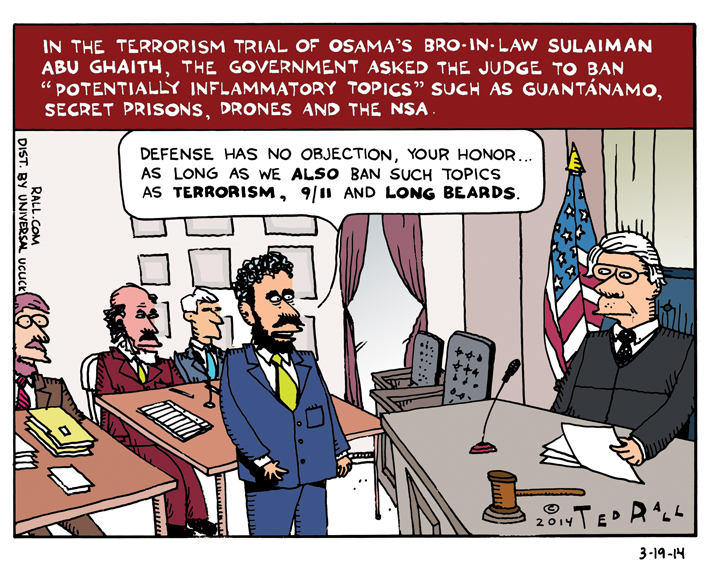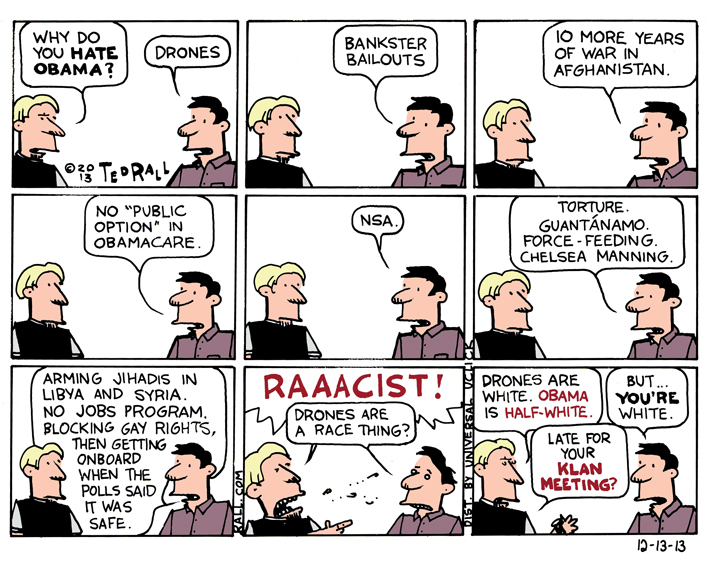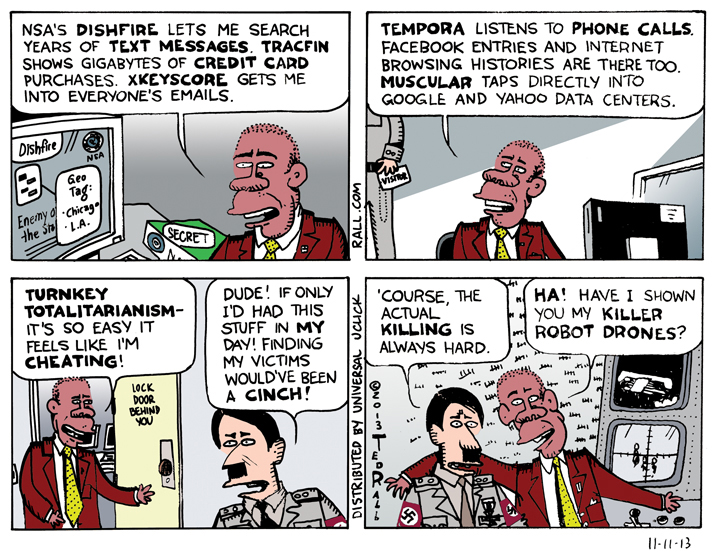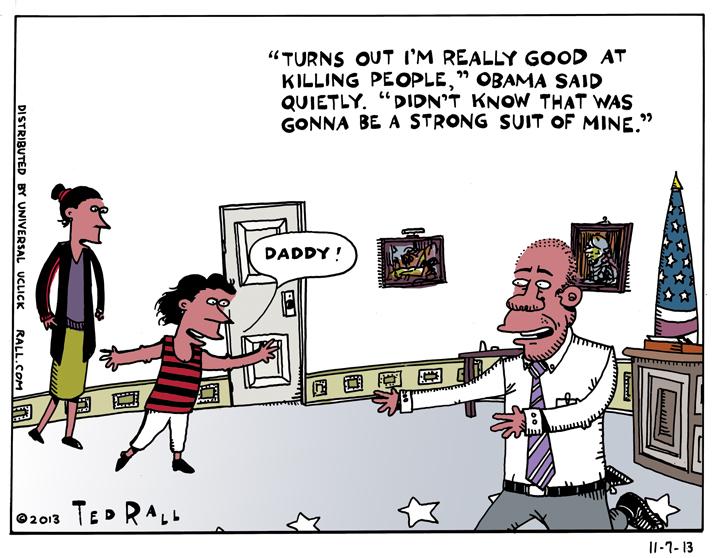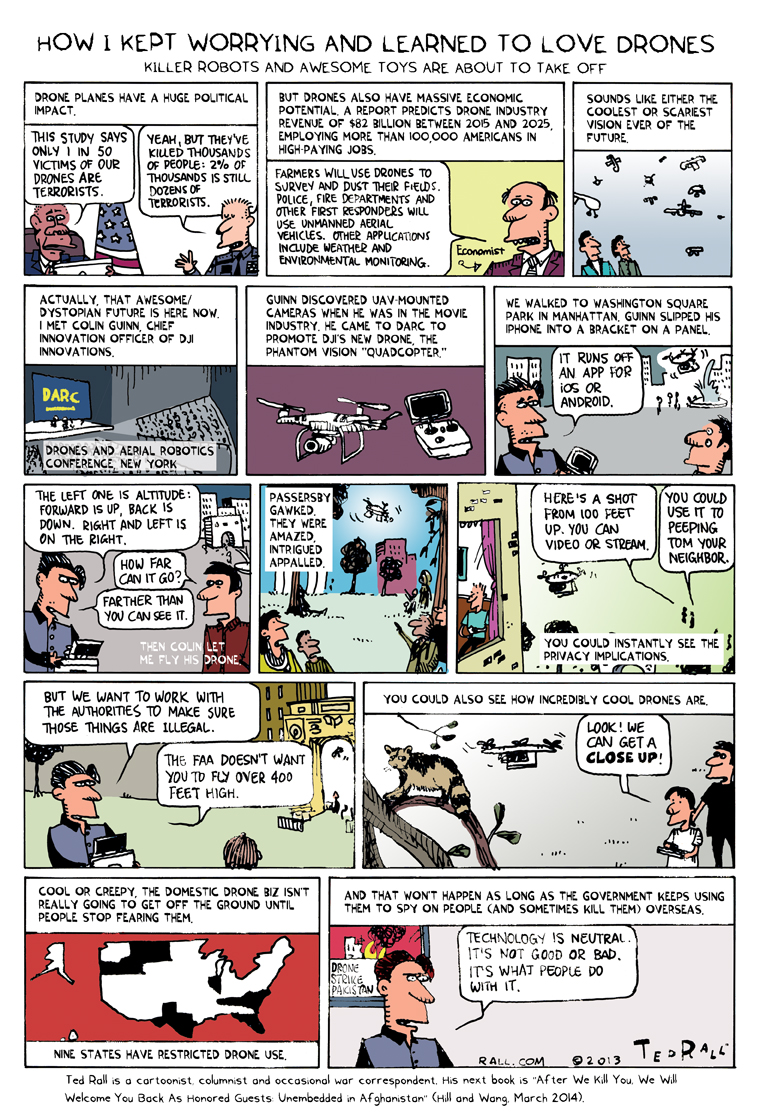In the terrorism trial of Osama bin Laden’s brother-in-law, government prosecutors asked the judge to ban “inflammatory subjects” such as Guantanamo, secret prisons, drones and the NSA.
Tricky Dick Meets the NSA
Even if you trust the Obama Administration with NSA programs that see everything we do online, drones that can blow us up and an executive order that allows the President to maintain a kill list of anyone he wants, anywhere he wants, they won’t always be in charge. How will you feel about those powers when someone like the paranoid Dick Nixon is in charge?
SYNDICATED COLUMN: What Would President Hillary Do? She’ll Be the First Woman President.
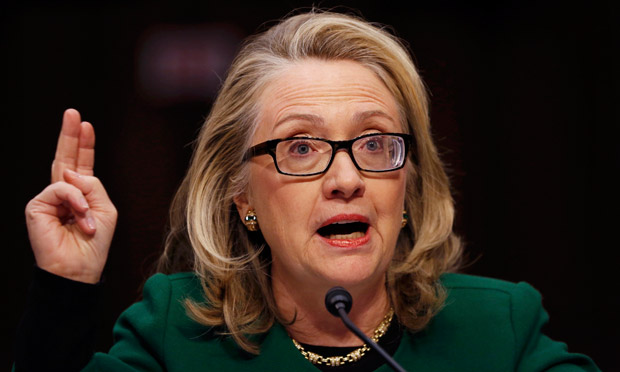
Hillary is the talk of 2016. Will she run? According to the pundit class whose water cooler speculation gets repackaged as “conventional wisdom,” the nomination is the former First Lady’s for the asking. Following a coronation that saves her cash and bruising primary battles, it’s currently hard to conjure a Republican who can stop her from taking the general election too.
But to paraphrase a recent viral music video, there’s one thing that no one knows:
What would President Clinton II do?
I posed this question to “Ready for Hillary,” the main pro-Hillary Super PAC. “Ready for Hillary focuses on grassroots organizing, not policy,” replied Seth Bringman. “Policy decisions would be up to the campaign if Hillary runs, which we are certainly encouraging her to do. We amplify the causes Hillary is advocating for and spread the word to our more than one-and-a-half million supporters. We have done so when Hillary spoke out on immigration reform, health care, voting rights, unemployment insurance, and the government shutdown.”
Given that the pre-primary season doesn’t begin for another 18 months, it’s a little early to expect a fully fleshed-out policy platform from a probable candidate. But HRC isn’t a fresh young thing. She’s been kicking around politics for decades — so it’s more than a little strange that neither her fans nor her enemies has a clue what she’d do about a host of issues.
Long before 2000, Al Gore’s longstanding interest in climate change signaled that the environment would have been a priority in his administration. Beginning with his testimony in the 1971 Winter Soldier hearings, John Kerry’s career path predicted a preference for diplomacy over war. On the other hand, it was similarly clear long before 2008 that a John McCain Administration would have been belligerent and quirky, featuring occasional alliances of convenience with Democrats.
So, what about Hill? The only agenda item anyone could have reasonably predicted was a revival of HillaryCare — which is now basically Obamacare. The biggest arrow in her quiver is gone.
Ready for Hillary says it has raised $4 million from 33,000 donors during 2013. That’s a lot of money. You’d think the donors would know what they’re buying, but if that’s the case, they’re keeping it to themselves.
Hillary leads every poll of the Democratic field for 2016. But why? What is it about her that makes some liberal voters swoon?
I combed the Internet looking for signs of something approximating a political agenda. I pushed out the following question to social networks: “Support Hillary for 2016? Can you tell me what she would DO?”
The closest approximation to an answer came back: “She would be the first woman president.”
Yeah, we knew that — but would she be a first woman president who fires drones at wedding parties, or a first woman president who pushes for a $20/hour minimum wage, or a first woman president who continues the first black president’s policy of not using government to try to create jobs? Would she be a first woman president who closes Guantánamo? Would she be a first woman president who continued NSA spying on Americans? Would she be a first woman president who adds a public option to the Affordable Care Act?
As far as I can tell, the (Democratic) arguments for Hillary boil down to the following talking points:
- Unlike Obama, who let himself get rolled by the Republicans, Hillary is tough and battle-tested. She’s a good negotiator.
- She’s an experienced manager. “Ready on day one,” she argued in 2008. She knows everyone and everything in government.
- Like her husband, she’s somewhat more liberal than Obama.
- She’s pre-disastered, thus electable. If there were any more Travelgates, Whitewaters, etc., the media would have uncovered them by now.
These are personality traits, not prescriptions for America.
Hillary Clinton isn’t a candidate — she’s a brand. She doesn’t offer a set of ideas; she projects a vague sense of competence that feels absent in the current White House. (Didn’t she used to hold some kind of big job in that place?) Despite having held high posts in government, she can’t point to a single major legislative or ideological achievement — but that doesn’t matter to her supporters.
Mostly, Hillary represents the potentiality of a historical symbol: first woman president. As soon as she takes the oath of office, her campaign’s biggest goal, shattering the ultimate political glass ceiling, will have been achieved.
If this feels familiar, it should. Senator Barack Obama was Clinton in 2006 and 2007, projecting calm after long post-9/11 years of jittery Bushisms, with a light resume that served as a blank slate, allowing people to project their hopes and ideals upon him. In the end, all that mattered was the beginning: winning as a black man. For the Obamabots, all that followed — protecting Bush’s torturers, the bankster bailouts, the drones, the NSA — was beside the point of their politics of identitarian symbolism.
What will happen to the long-term unemployed under Hillary? If 2008 serves as a guide, the 2016 campaign will pass without Americans much talking or thinking about such questions.
(Support independent journalism and political commentary. Subscribe to Ted Rall at Beacon.)
COPYRIGHT 2014 TED RALL, DISTRIBUTED BY CREATORS.COM
SYNDICATED COLUMN: Why Don’t Kids Want to Study Engineering? Because Engineering Friggin’ Sucks.

Sexing Up Science Won’t Solve a Dearth of STEM Majors
According to a survey, nearly 90% of 16- and 17-year-olds have no interest in a STEM (science/technology/engineering/math) career.
The climate is crashing, the NSA is tracking our porn, and the 99% haven’t gotten a raise in decades, but the party organ of America’s ruling class is truly, awfully worried about our imminent STEMlessness. A lot.
“The number of students who want to pursue engineering or computer science jobs is actually falling, precipitously, at just the moment when the need for those workers is soaring,” writes The Editorial Board of The New York Times, which is composed of editors no one has heard of, yet whose opinions we are all supposed to care about. “Within five years, there will be 2.4 million STEM job openings,” write The Editors.
Who, in the future, will program the great fleets of killer drones? Who will pilot them? It would suck to lose that business to the Chinese.
Whenever the question of Why No One Wants to Study Engineering comes up, the media always comes back with the same answer: conning convincing kids that STEM stuff isn’t boring.
“Most schools continue to teach math and science in an off-putting way that appeals only to the most fervent students,” the Times editors complain. Sex up the sciences — that’s the ticket!
Texas Instruments (they’re still around?) has hired neuroscientist/”Big Bang Theory” actress Mayim Bialik as a “STEM education brand ambassador” to sing the praises of partial differential equations using framing that the Kids of Today/Worker Bees of Tomorrow can relate to. “Who doesn’t know something about zombies or superheroes?” asks Bialik. “These cultural archetypes can do more than just entertain. Zombies, it turns out, can teach real science and mathematical concepts like exponential growth curves and the intricacies of human anatomy and anatomical degradation. Superheroes can prompt a variety of questions that draw on physics, such as: How does one actually travel faster than the speed of light?”
Is it me, or does this seem a little…forced?
Hey, I’m as geeky as they come. When an engineer who designed famous roller coasters gave a talk at my Ohio high school, I was enthralled. (My classmates, not so much.) But I still didn’t want to study engineering — and it wasn’t because science is boring.
I loved math, chemistry and physics in high school. I studied years ahead. I got perfect grades and tested so well that Columbia’s School of Engineering offered me a full scholarship and a well-paid teachers assistant job.
Still, I didn’t want to go. Not because math and science bored me — to the contrary. I dreaded it because I knew engineering school would probably be a sucky experience and that a career in the sciences would be depressing.
Not that my parents cared what I wanted. They bullied me into going anyway because (a) Columbia gave me the most financial aid of the schools I applied to, and (b) something “practical” like engineering guarantees a steady well-paid job after graduation. (Ha.) So off I went.
Guess what? Engineering school was a sucky experience.
My experience at Columbia highlights reasons — aside from the alleged tedium of math and science — that most young people aren’t interested in the STEM professions:
- When you study math and science, your classmates are boring. At Columbia the engineering majors were politically disengaged, careerist, nose-to-the-grindstone types you’d never find working over the world’s problems at an overnight BS session — much less checking out a punk concert. They were academically smart and deadly dull. After graduation, people similar in personality to your fellow students become your colleagues. Engineering isn’t boring. Engineers are. Working with boring engineers is a bummer.
- STEM majors get much lower grades than liberal arts majors. Tougher grading causes lower GPAs, so dropout and expulsion rates are also much higher: three out of four liberal art majors get a degree, only one out of four STEM majors. During freshman orientation, Columbia’s dean of students told us that 75% of us would drop out or get expelled. I wondered why I was there. (After three years, I was expelled with a 2.4 GPA. Which I worked hard for.) Why take out massive student loans for a one-in-four chance at a degree? Though some studies deny the difference, 60% of freshman engineering students are gone, dropped out or transferred to the liberal arts, by the end of their freshman year. These kids aren’t stupid or lazy — they were smart and studious enough to get admitted in the first place.
- Low social status. Guys don’t make passes at girls who wear safety glasses; girls suddenly remember something they forgot in the ladies room when you tell them you’re an electrical engineer. Because (see above) engineers are boring. Also: in America’s anti-intellectual culture, it’s not cool or hip or prestigious to be a scientist.
- STEM employment is sporadic (they say “cyclical”). What’s the point of playing it safe when it’s not, well, safe? The STEM major you pick as a freshman may easily be obsolete by the time you hit the senior year job fair. Even if not, it’s extremely unlikely your chosen scientific field will provide steady employment for years to come. Currently, as the Powers That Be say they need STEMmers, unemployment is sky high among STEM professionals. As of 2009, nearly 9% of electrical engineers were jobless. Oh, and it turns out that STEM majors actually don’t earn more than their liberal arts counterparts.
“Indeed, science and engineering careers in the U.S. appear to be relatively unattractive” compared with other career paths, Michael Teitelbaum of the Alfred P. Sloan Foundation in New York, which funds basic scientific, economic and civic research, testified to Congress in 2007.
High-school students know what’s up. They hear from older siblings how hard it is to graduate from engineering school. They watch their friends’ parents lose their jobs from supposedly “safe” STEM outfits. They’re not going to change their minds until reality improves.
Some fixes:
- De-ghettoize STEM majors within colleges and universities. Require STEM majors to take lots of liberal arts classes — it’s not like a math major shouldn’t study Spanish literature — and require liberal arts majors to take more math and science. Mix up the student bodies. Think about someone like Steve Jobs, whose design sense came from his love of art and calligraphy. The divide between English and physics majors is artificial and outdated. Crosspollinate.
- Put an end to the grading disparity between STEM majors and liberal arts. It’s unfair and it’s stupid. At Harvard, the average grade is an “A-“, and why not? The average Harvard student is intelligent and hardworking — and so is the average Columbia engineering student. Harvard’s softer grading regime hasn’t cost the school any reputation points.
- If America wants STEM majors from America, it ought to stop importing them from overseas. “When the companies say they can’t hire anyone [for STEM jobs], they mean that they can’t hire anyone at the wage they want to pay,” Jennifer Hunt, a Rutgers University labor economist, said in 2012. So they outsource STEM jobs overseas and game the work visa program to import cheaper foreign scientists. “Tech companies that import temporary workers, mainly recent graduates from India, commonly discard more expensive, experienced employees in their late 30s or early 40s, often forcing them, as Ron Hira and other labor-force researchers note, to train their replacements as they exit,” reports the Columbia Journalism Review. Until STEM unemployment among Americans is 0%, Congress ought to get rid of the visa program.
- Even cultural perceptions can be changed. If President Obama and other members of the political class are serious about promoting STEM careers, they could start featuring our best mathematicians and chemists at events like the State of the Union Address rather than the usual parade of military veterans. The Soviet Union pimped its scientific minds big time; kids who admired these intellectual heroes followed in their footsteps.
Math and science aren’t boring. But asking people to dedicate their lives to careers that won’t pay off is dumb.
(Support independent journalism and political commentary. Subscribe to Ted Rall at Beacon.)
COPYRIGHT 2013 TED RALL
The Death of Jar Jar Binks
Jar Jar Binks is one of the most despised movie characters in history. For a zine titled The Death of Jar Jar Binks, numerous cartoonists were asked to depict the demise of the Star Wars character anyway way they chose, with the execution being reminiscent of a shitty 1980s black-and-white zine.
I love doing these weird non-political cartoons (though this has a political angle, of course). I used to do them a lot during the 1980s and 1990s, but the market for strictly humorous cartoons has dried up.

